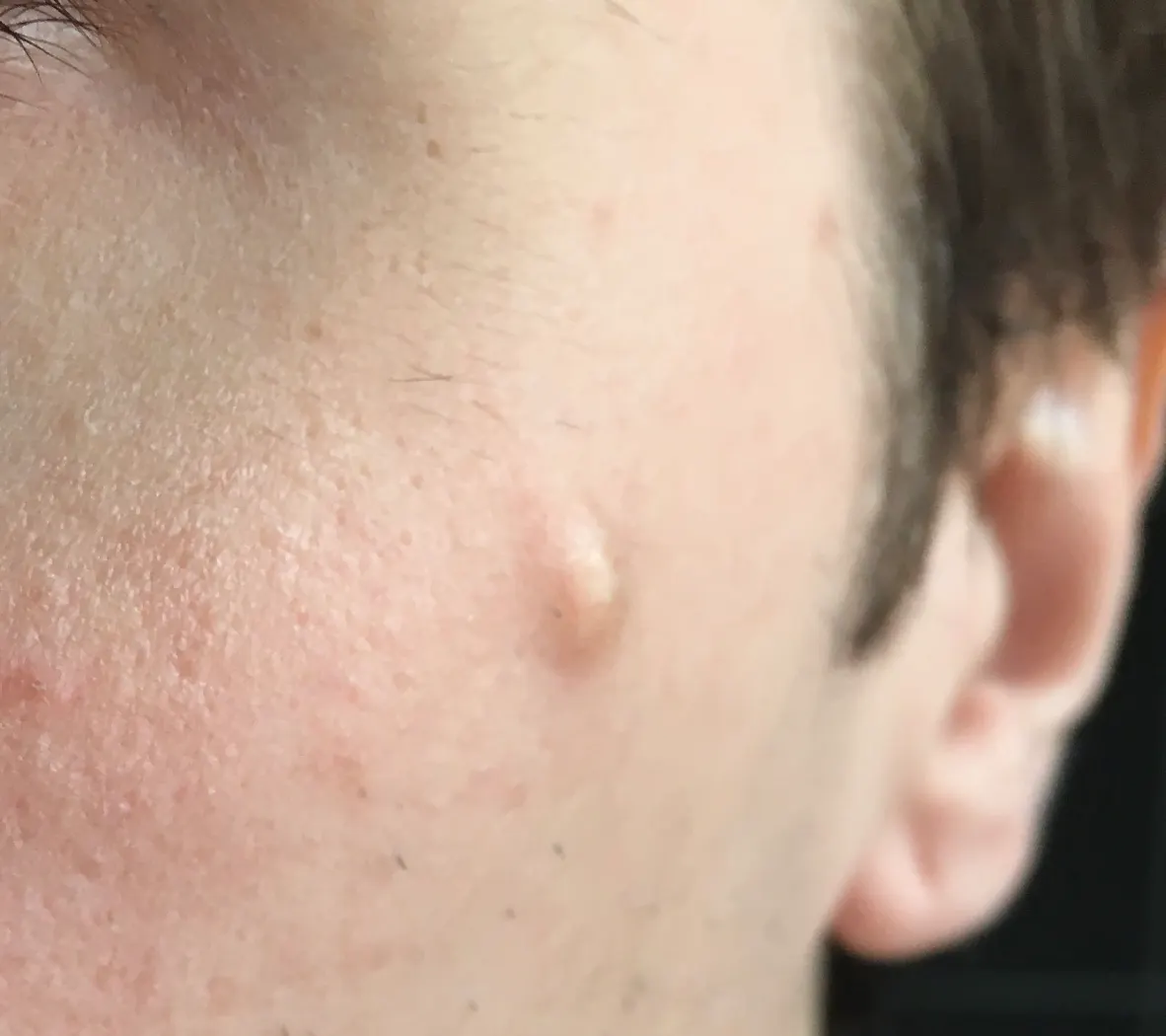Expert Sebaceous Cyst Removal in Edinburgh
Embarrassed by a sebaceous cyst or dealing with a painful infected one? Our consultant plastic surgeons provide expert cyst management – from immediate drainage of infected cysts to complete surgical excision once healed. Unlike simple drainage that often leads to recurrence, we remove the entire cyst sac when appropriate.
At £695 for cysts under 2cm, we offer same-day treatment at our 5-star Edinburgh hospital with no GP referral needed. While some NHS services have size restrictions or long waiting times, we treat cysts of any size causing discomfort or cosmetic concern. Whether on your face, scalp or body, our GMC Specialist surgeons use precise techniques for minimal scarring. Get expert sebaceous cyst treatment across Edinburgh and Scotland.

Contents
Overview
- TYPE OF ANAESTHETIC
Local - LENGTH OF SURGERY
30-45 minutes - HOSPITAL STAY
Walk in walkout - RECOVERY
1-2 days

Understanding sebaceous cysts
Sebaceous cysts, also known as epidermoid cysts or keratin cysts, typically develop when the sebaceous glands – the glands in the skin that produce an oily substance called sebum – become blocked. Several factors can contribute to the formation of these cysts:
- Blocked Hair Follicles: Hair follicles can become blocked due to a buildup of keratin, a protein that is part of skin, hair, and nails. This blockage can lead to the formation of a cyst.
- Skin Trauma: Injury or damage to the skin, such as a scratch, surgical wound, or a skin condition like acne, can disrupt normal skin structures and lead to cyst formation.
- Hormonal Changes: Fluctuations in hormones, particularly during puberty, pregnancy, or menopause, can increase the likelihood of sebaceous cysts as they can stimulate the sebaceous glands.
- Genetic Factors: In some cases, there might be a genetic predisposition to developing cysts. Certain genetic conditions, such as Gardner syndrome or basal cell nevus syndrome, are associated with multiple cysts.
- Inflammatory Skin Conditions: Conditions like acne can increase the risk of developing cysts due to inflammation and blockage of the skin’s glands and hair follicles.
Further reading: Skin cysts NHS

Private treatment options
At Waterfront Private Hospital, we offer comprehensive treatment options for sebaceous cysts tailored to each patient’s needs. Our experienced team provides safe and effective methods to address both the symptoms and cosmetic concerns associated with these cysts. The treatment options include:
- Observation: Small, asymptomatic sebaceous cysts may not require immediate treatment. We often recommend monitoring them for any changes.
- Incision and Drainage: This procedure can provide immediate relief for swollen and painful cysts. The cyst is incised, and the contents are drained. However, this method has a high recurrence rate since the cyst sac is left behind.
- Antibiotics: If the cyst is infected, antibiotics may be prescribed to clear the infection. However, antibiotics do not treat the cyst itself.
- Surgical Excision: This is a more definitive treatment where the entire cyst, including its sac, is surgically removed. This method minimises the chance of recurrence and is performed under local anaesthesia.
- Minimal Excision: This technique aims to remove the cyst with minimal scarring. It involves a smaller incision and careful extraction of the cyst.
Our team at Waterfront Private Hospital ensures that patients are thoroughly informed about their options and are involved in the decision-making process for their treatment. We focus on providing personalized care, considering factors such as the size and location of the cyst, the patient’s skin type, and personal preferences.
Aftercare is an essential part of our treatment process, with detailed instructions and follow-up appointments to ensure proper healing and patient satisfaction.
Frequently asked questions
How Common Are Sebaceous Cysts?
These cysts are common and can occur on any part of the body, though they are most frequently found on the face, neck, and trunk.
What Causes Sebaceous Cysts to Form?
They typically result from blocked sebaceous glands, trauma to the skin, or due to swollen hair follicles. Genetic factors can also play a role.
Are Sebaceous Cysts Painful?
Generally, they are painless. However, if a cyst becomes inflamed or infected, it may become painful and tender.
Can Sebaceous Cysts Lead to Cancer?
These cysts are typically benign. However, any significant changes in size, colour, or pain level should be evaluated by a healthcare professional to rule out malignancy.
What are the Treatment Options Available?
Treatment can include watchful waiting, incision and drainage, or surgical removal, especially if the cyst is large, painful, or infected.
Is Home Treatment Advisable?
We advise against at-home treatments like squeezing or popping a cyst, as this can lead to infection and scarring. Professional medical treatment is recommended.
Do Sebaceous Cysts Recur After Treatment?
There is a possibility of recurrence, especially if the cyst sac isn’t completely removed during treatment.
How Can I Distinguish a Sebaceous Cyst from Other Skin Conditions?
Sebaceous cysts have a distinct feel and appearance, often presenting as round, movable lumps under the skin. However, a medical diagnosis is necessary for accurate identification.
Are Certain People More Prone to Developing Sebaceous Cysts?
Factors like a history of acne, skin trauma, or genetic predisposition can increase the likelihood of developing sebaceous cysts.
Can Diet or Lifestyle Influence Sebaceous Cyst Formation?
While diet and lifestyle directly influencing cyst formation are not well-established, maintaining overall skin health through a balanced diet and good hygiene may be beneficial.
What Should I Do if a Sebaceous Cyst Becomes Infected?
If a cyst becomes red, swollen, painful, or starts draining, it may be infected. Immediate medical attention is recommended in such cases.
Can Hormonal Changes Affect Sebaceous Cysts?
Hormonal fluctuations, particularly during puberty, pregnancy, and menopause, can influence the activity of sebaceous glands and potentially affect cyst formation.
Does Sun Exposure Impact Sebaceous Cysts?
Direct sun exposure doesn’t directly cause sebaceous cysts, but protecting the skin from excessive sun is always advised to maintain overall skin health.
Is There Any Way to Prevent Sebaceous Cysts?
While there’s no sure way to prevent them, maintaining good hygiene, avoiding skin trauma, and treating underlying conditions like acne may help reduce the risk.
Page author
Dr. Omar Quaba, MBBChir, FRCS (Plast), GMC 4586300, is a Consultant Plastic Surgeon with over 20 years of experience in plastic surgery. Based at Waterfront Private Hospital in Edinburgh, he is fully accredited on the GMC Specialist Register and specialises in advanced cosmetic procedures. Full member of BAAPS.
